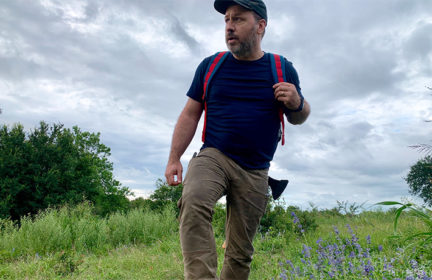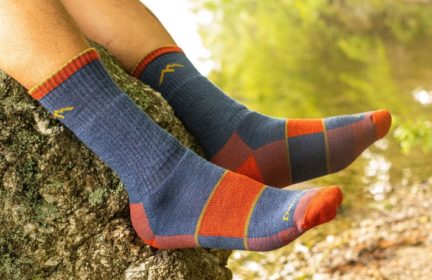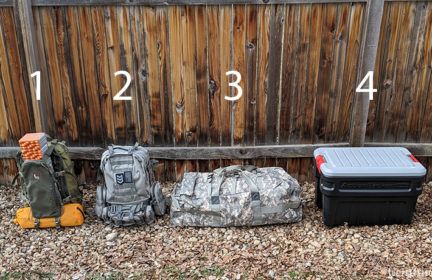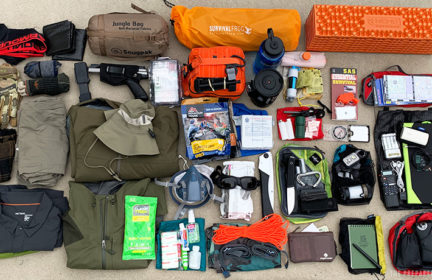Best jacket/outer layer for the BOB?
I am looking for advice for a light-weight, space conscious (and hopefully budget conscious) option for my outer layer of clothing in my BOB. Right now I’m using a ridiculously bulky sweater, which is taking up way too much room. I don’t necessarily need this layer to be waterproof as I’m thinking of purchasing a cape/shelter thing for rain.
Here are my considerations:
- I’m a large person. Short, but big around. (and I prefer men’s clothing)
- I’m in Northern California. Our evenings can definitely get chilly, especially in the winter, but not usually below the mid 40s. Really cold winters have gotten into the 30s.
- I get hot easily, although in truth these days my temp regulation is kind of wacky and I can also get cold the next minute. But generally I don’t like to get too hot and don’t tolerate heat very well.
- I’m on a budget. I don’t have a lot of money. I do put aside about $45/month for prepping and I will save up for a more expensive item, but price matter.
- I don’t have a lot of space in my BOB — which I guess is true for most of us.
So, any suggestions?-
-
Comments (19)
-
NazSMD - November 14, 2020
A traditional way to think about this is to use layering. For example, a wicking undergarment/base layer next to the skin (wool and capilene fabric are popular options), an insulating layer to go over that (synthetic fleece or a synthetic light puffy are good options in your climate), and finally an outer shell for wind and rain (there are a whole range of options there from cheap to pricey, with various ranges of breathability combined with the waterproofness; that shell can also go directly over the base layer when it’s warmer but windy or rainy). This system also lets you add additional layers such as a shirt appropriate around town, or a warmer insulating layer if you end up in colder climes. Perhaps that helps sort out options…
-
pnwsarahContributor - November 14, 2020
I agree with NazSMD’s layering suggestion. To bring the price down, I wonder about planning to repurpose/rotate items out of your regular wardrobe and/or thrifting. This is how I packed my BOB with clothes. For example, here is all my upper body stuff:
- a UPF 50 longsleeve sunshirt that I bought originally for running and then used for home improvement projects before it was sent to the BOB
- a zip-neck fleece pullover that my friend found at one of those pay-by-the-pound thrift stores
- an old down jacket, originally bought on sale in January (when all the warm stuff gets discounted!), that I wore for six winters and had to stop using as my go-to because it was in rough aesthetic shape and had lost some warmth
- a rain jacket we got for free from a workplace lost and found just before long-unclaimed items were donated
The fleece and the down jacket would easily have cost >$300 new— and when they were new, they would have been too bulky to fit easily in my BOB. The down jacket is not as warm as it once was, but with the fleece, I think it’ll be fine.
Granted, we do a lot of outdoor sports in my household and friend group, so there is a certain amount of technical outwear getting acquired and abused and seeking a second or third home or role in my orbit, which I know is not the case for everyone! But you can try apps like Poshmark and those extra-super-cheap thrift store “last call” centers (the only one I’ve been to— which was in NorCal— was located in an industrial garage type building with huge roll-up garage-style doors that were kept open, so those types of setups might even be Covid-friendly).
Wool button-down shirts are another good item that could be relatively easy to thrift or e-thrift, and if you get warm easily, jackets with pit zips are great for temp regulation.
Hope some of those ideas are helpful!
-
Little Bear’s Mom - November 15, 2020
Since your climate doesn’t get super cold, you hate being overly warm, and you’re planning on getting a good outer rain layer anyway, you might think an getting a good insulated vest instead of a jacket. They’re usually a little cheaper and might be the right mid-layer for you. I got a really warm down vest from a very good brand on clearance at the end of the season last year for about $25. You can find packable versions on Amazon now for under $30.
-
Jonnie PekelnyContributor - November 19, 2020
Thanks for the idea. Unfortunately, it’s my arms that get cold first so vests never really do much for me.
-
-
CP - November 19, 2020
I would suggest a waterproof, breathable shell. They are lightweight, pack up small and will hold in a fair bit of heat, as well as reducing the heat lost to wind. You can then layer other clothing underneath – I would suggest a thin or medium fleece, plus a fleece hat. I think that you will find a jacket also much more functional than a cape/poncho.
You can buy a basic waterproof, breathable shell for less than $100 dollars. REI has them for about $90. I have one from Marmot I got for about that price that I am happy with. Just make sure that you buy one with armpit venting (big zippers you can open under your arms) which will help with temperature regulation.
As for finding a fleece, I think you may be able to find a nice enough one thrifting. The Amazon Basics option (about $30, the last time I checked) is also reasonable quality.
-
Jonnie PekelnyContributor - November 19, 2020
Thanks for the idea! So, are you basically suggesting a t-shirt, fleece and breathable waterproof shell combo as my layers?
The other thing I wonder about is bottom layers. Shorts or pants obviously. But is a warmer layer (thermal underwear?) necessary? And, more importantly, what about waterproofing? I never see this discussed in emergency clothing, but whenever I walk around in the rain in my waterproof top layer, my pants get wet, or, worse, soaked. That seems important to avoid in an emergency scenario, but adding rain pants and all the other stuff could make things really bulky in the clothing department — I mean for storage room and weight purposes in the BOB.
-
CP - November 19, 2020
Yes, that is what I am suggesting, plus a hat. Just – as others have said – find a synthetic T-shirt instead of a cotton one. It doesn’t have to be a fancy technical fabric; an old nylon running shirt is fine. Maybe a short sleeve one in the summer, a long sleeve in the winter.
You are right about the bottoms issue. I’ve seen very few people bother with waterproof pants (probably because of expense, bulk, or heat), but you will get soaked from the waist down in really wet weather. Instead of getting waterproof pants, however, it may be more practical to get some nylon pants (track suit bottoms are fine) that will dry out quickly, and then pack some polyester long johns or old tights/leggings (again, synthetic fabrics only) in a ziplock to change into whenever you get to shelter. Then let the nylon pants try out.
More generally, I don’t find an insulating layer on the legs necessary during physical activity. Plus it can be hard to take on and off, and it is important to keep regulating your layers so that you don’t sweat too much. The chill from your sweat is what can really make you cold later. (That’s also why I like having a hat – it’s easy to take on and off and can change your temperature a lot.) Having an insulating layer can be good for sleeping or around camp, but your the long johns / tights can serve that purpose: you can wear them to sleep or double them up with your windpants for around camp in severe cold.
-
Alicia - November 24, 2020
I am in SoCal with similar temperature ranges but typically am cold vs. hot. I’ve outfitted both my BOB (curvy female) and one for my large/tall husband so I empathize with the challenges of size range. I used the layering concept that CP describes herefor the BOBs and when I travel or backpack. I’ve had decent luck on Ebay once I knew what brands and items I was seeking. So do some research to find which brands of clothing using outdoor technical fabric offer the size range you’re seeking (extended sizes aren’t available in too many brands). I have had luck with North Face, Columbia, Mountain Hardwear, Eddie Bauer (including First Ascent their mountaineering internal brand), and LL Bean. I also watched for sales at those brand’s sites and/or signed up for email deals. I saw an LLBean sweater fleece hooded jacket in Men’s Tall XL eventually go down by 50% and I could add a deal on top. I also found an Eddie Bauer First Ascent Cloud Fleece which is a lighter layering weight (more packable) for $20 in Mens XL Tall on Ebay. I put the cloud fleece in the car GHB and the the sweater fleece which is bulkier in the BOB. It is pushed in every open pocket of space in the BOB pack so it’s sort of encapsulating all of the contents, but I got it in where it didn’t appear it would fit at all.
As for lower body, I also included some old polypropylene long underwear in black that I can use as bug/sun protection leggings in warmer weather and/or pajamas. I’m considering some rain chaps to protect my legs in a downpour – which isn’t likely where I live so it’s still pending. My experience with rain pants has been they’re too hot (and I freeze if you recall), or hard to get on/off as weather changes. The chaps remove the layers around the waist/crotch to address both issues. Depending on the jacket on top, they may not cover enough.
-
Jonnie PekelnyContributor - November 30, 2020
Thanks for all those ideas. A few comments:
Does a mix of cotton and polyester or wool work as a bottom layer? I hate wearing 100% polyester.
What do you mean by windpants?
I’m wondering if something like this will work for the waterproof shell. It seems to extend fairly low beyond the waist. https://www.sixmoondesigns.com/products/gatewood-cape?variant=14706758615082
-
Little Bear’s Mom - November 30, 2020
The problem with cotton is that the fibers hold onto moisture, and that ultimately ends up making you colder. If you don’t want something purely synthetic, you’re better off with a wool/synthetic blend than a cotton/synthetic blend. I’ve found fairly inexpensive nylon/wool or poly/wool baselayers for my husband at discount stores like Sierra.
-
Jonnie PekelnyContributor - November 30, 2020
Yes, I can look for a wool blend, but is wool so good in the summer? I’m more likely to get hot than cold.
-
Alicia - November 30, 2020
I get that too. I also don’t like the feel of polyester generally and it makes me hot too as it doesn’t breathe. I’d rather be cold than hot as I can dress for the cold and tend to be cold (fortunate for me). So if I do get hot, I’m pretty miserable. In the very hot summers in SoCal, I was really resistant to wool which I embraced and really loved on a winter vacation. So I tried out the Icebreaker Spector 150 weight tee on a 90 degree day. I was surprised that it was cooler than the cotton tee I took off to don it and it was navy blue. Dark color necessary because it’s such a thin fabric. There are better synthetic options now than in the past and some knit, brushed poly tees feel more like cotton and the wool blends with nylon for durability have worked for me. Neither are swampy like poly of the past. Polypropylene has been the synthetic that works most like cotton for me. It’s not as prevalent as it used to be.
The other bonus of wool over synthetics is that it doesn’t retain the odors that the synthetics do. It’s naturally more antimicrobial. On that winter vacation we really could wear items multiple times. But granted, that wasn’t a sweating scenario.
-
Alicia - November 30, 2020
I have a Gatewood cape as my rain cape/poncho and tent/shelter to save weight and it also covers my pack. It’s a bit long for me at 5’5″ so I have a stretch cord belt to tuck it/connect the tips into and to keep it from flying/floating about. Another reason I’m not making lower body rain protection a priority. The Gatewood does work well as a tent too for folks that aren’t over 6′. I didn’t want to rely on that solely as an outer layer for cooler dry days so I added a Patagonia Houdini wind jacket that is ultralight and from the reviews pretty water resistant. No hand pockets though. And the wind jacket provides some rain protection when the Gatewood is serving as a tent.
-
rangerjohn - September 1, 2022
Thanks for the information on the Gatewood, I had never heard of one before. Now, I have one on the way.
-
rangerjohn - September 1, 2022
I like it, I would use chaps under it.
-
Alicia - September 1, 2022
I’m glad to have helped. I also got the Serenity Net, but also saw some YouTube reviews that used only a bug net underneath which is lighter/smaller.
-
-
Bob - December 5, 2020
Jonnie, I’m not answering your question; just providing some information for building up a knowledge base in re field clothes.
Take a glance at http://www.forestry-suppliers.com This is not a recommendation of the company nor the products. I’m posting it here to read about the clothing descriptions and functions.
Take a glance at the catalog section on fire fighting and the “Brush Pants”. Note the “Wildland Fire Pants. There’s also a “Fireline brand “Overpants”. There’s also an entry for “Smokechaser Advance Fabric Firefighting Overpants”.
Everything is expensive and not recommending anything; just the information for a developing a knowledge base. They have shirts also and worth a glance.
My usual method for procuring something is to learn about the best product. Next I would “shop around” – especially at the Walmart workclothes section.
Again, ignore the prices in the catalog. It’s priced for corporate and public sector purchasing.
-
David Hinksan - August 30, 2022
The best jacket for the bug out bag (BOB) is the one which has the features that have been discussed in the video above. You should have snug fitting clothing which will not snag on branches when you are running through the woods. You might want to check the video above once again to make sure that you have not missed any important feature. To get the best jacket, you should be well aware of the latest trends in outdoor gear. You should have a thorough knowledge of all the latest gear to get the most value for your money. Here you will learn about the base layer and I’m going to wear kora as my ski base layer.
-
Sherm - August 30, 2022
I saw a mail carrier with a cloak style raincoat, hung to about his knees. That style looked good to me. He had his bags underneath, and said he wore that in heat or cold, because his layering underneath would keep him cool or warm, depending. It either had a hood or he wore one of those pith helmet hats. You could look at a uniform supply place and find something similar.
-
- News for the week of 2025-07-07 - 2 days ago
- Fun ways to teach kids outdoor/survival skills - 1 week ago
- News for the week of 2025-06-30 - 1 week ago
- News for the week of 2025-06-23 - 2 weeks ago
- News for the week of 2025-06-16 - 3 weeks ago
This forum is heavily moderated to keep things valuable to as many people as possible. Full community policies are here. The basics:
- 1. Be nice to each other.
- 2. Stay focused on prepping.
- 3. Avoid politics, religion, and other arguments.
- 4. No unfounded conspiracies, fake news, etc.
- 5. Debate ideas, not people.




